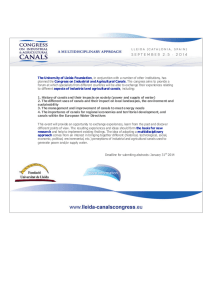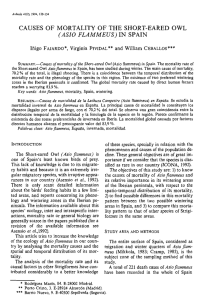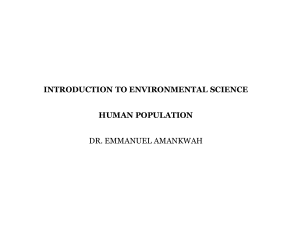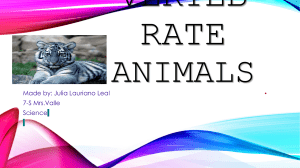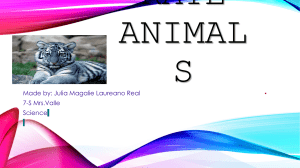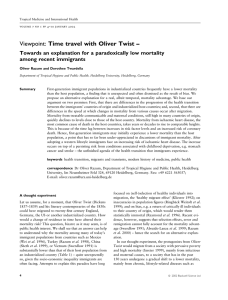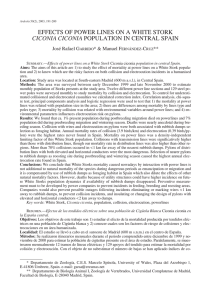Mortality of vertebrates in irrigation canals in an area of west
Anuncio
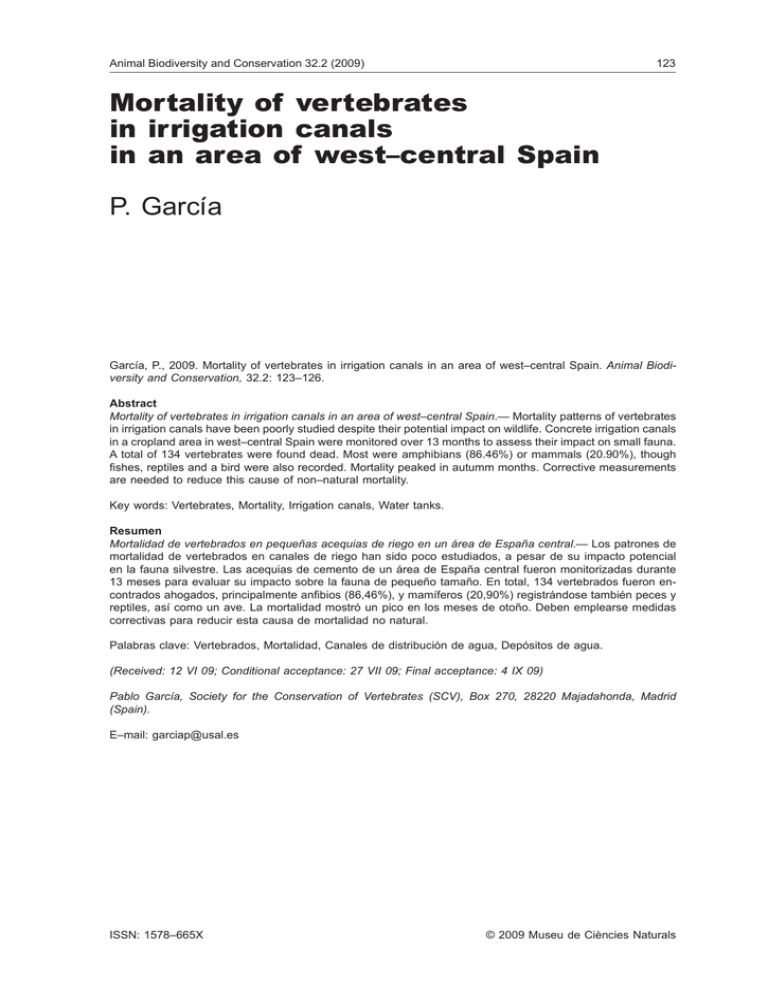
Animal Biodiversity and Conservation 32.2 (2009) 123 Mortality of vertebrates in irrigation canals in an area of west–central Spain P. García García, P., 2009. Mortality of vertebrates in irrigation canals in an area of west–central Spain. Animal Biodiversity and Conservation, 32.2: 123–126. Abstract Mortality of vertebrates in irrigation canals in an area of west–central Spain.— Mortality patterns of vertebrates in irrigation canals have been poorly studied despite their potential impact on wildlife. Concrete irrigation canals in a cropland area in west–central Spain were monitored over 13 months to assess their impact on small fauna. A total of 134 vertebrates were found dead. Most were amphibians (86.46%) or mammals (20.90%), though fishes, reptiles and a bird were also recorded. Mortality peaked in autumm months. Corrective measurements are needed to reduce this cause of non–natural mortality. Key words: Vertebrates, Mortality, Irrigation canals, Water tanks. Resumen Mortalidad de vertebrados en pequeñas acequias de riego en un área de España central.— Los patrones de mortalidad de vertebrados en canales de riego han sido poco estudiados, a pesar de su impacto potencial en la fauna silvestre. Las acequias de cemento de un área de España central fueron monitorizadas durante 13 meses para evaluar su impacto sobre la fauna de pequeño tamaño. En total, 134 vertebrados fueron encontrados ahogados, principalmente anfibios (86,46%), y mamíferos (20,90%) registrándose también peces y reptiles, así como un ave. La mortalidad mostró un pico en los meses de otoño. Deben emplearse medidas correctivas para reducir esta causa de mortalidad no natural. Palabras clave: Vertebrados, Mortalidad, Canales de distribución de agua, Depósitos de agua. (Received: 12 VI 09; Conditional acceptance: 27 VII 09; Final acceptance: 4 IX 09) Pablo García, Society for the Conservation of Vertebrates (SCV), Box 270, 28220 Majadahonda, Madrid (Spain). E–mail: [email protected] ISSN: 1578–665X © 2009 Museu de Ciències Naturals García 124 Introduction Material and methods The effects of irrigation canals on vertebrates have been little studied in comparison with other causes of non–natural mortality. However, water conduction systems can affect vertebrates in a similar way to highways (Forman & Alexander, 1998; Rosell et al., 2002), creating a barrier effect or causing mortality. Several authors (Cushman, 2006) consider that the barrier effect has a more negative impact than mortality in this setting, but certain populations of small and medium–sized vertebrates are at serious risk of drowning in irrigation canals (Ramos, 1992; Arranz, 1994; SCV, 2000; García, 2006a). Such mortality appears to occur in this setting simply because animals may fall into these canals as they move around their home ranges (see however Rosell et al., 2002; Peris & Morales, 2004). Several solutions have been proposed to avoid this cause of non–natural mortality, but little is known about their effectiveness. In this work, we studied seasonal patterns of vertebrate mortality in irrigation canals in an attempt to further our understanding about the main groups involved and the extent of the involvement. Such knowledge could contribute to effective solutions in future. The irrigation canals in this study were concrete structures designed for transporting water in the vicinity of Fresno Alhándiga (40º 42' 36.43'' N 5º 36' 16.58'' W; 820 m a.s.l.; fig. 1), east of the province of Salamanca, in west–central Spain. This locality has a typical continental Mediterranean climate. Since the construction of the Santa Teresa dam, croplands have become the predominant land use. The area has a complex network of water bodies that includes rivers, streams and gravel pits, and well developed riparian forest. The irrigation canals are small and the water tanks, where the water coming from these ditches is stored, measure on average 81.44 ± 2.03 cm (mean ± SE; n = 29) length, 82.60 ± 2.16 cm wide, 154.97 ± 8.08 cm depth. The canals are used to conduct and distribute water to croplands in the region. Canals transport water from May to August, whereas water tanks remain full almost all the year, although their level diminishes during the winter. To evaluate the impact of these irrigation canals on vertebrates from October 2004 and December 2005 we carried out monthly monitoring of water tanks along about 2 km of the irrigation canal system as it is in these structures where carcasses accumulated whenever animals died in the ditches. Table 1. Vertebrate mortality in west–central Spain water deposits from 2004–05: I. Incidence (number of animals found). Tabla 1. Mortalidad de vertebrados en depósitos de agua en España central durante 2004–05: I. Incidencia (número de animales encontrados). Species / group I Species / group Chub, Squalis carolitertii 4 Wood mouse, Apodemus sylvaticus Total fishes 4 Brown rat, Rattus norvegicus I 8 13 House mouse, Mus musculus 1 Sharp–ribbed salamander, Pleurodeles waltl 4 Common vole, Microtus arvalis 2 Marbled newt, Triturus marmoratus 3 Lusitanian pine vole, Microtus lusitanicus 3 Western spadefoot, Pelobates cultripes 1 Rabbit, Oryctolagus cuniculus 1 5 Total mammals Common toad, Bufo bufo Iberian water frog, Pelophylax perezi 83 Total amphibians 96 Ladder snake, Rhinechis scalaris 28 House sparrow, Passer domesticus 1 Total birds 1 2 Montpellier snake, Malpolon monspessulanus 1 Viperine snake, Natrix maura 1 Grass snake, Natrix natrix 1 Total reptiles 5 Total vertebrates 134 Animal Biodiversity and Conservation 32.2 (2009) 125 40 % mortality 35 30 25 20 15 10 5 0 J F M A My Jn Jl A S O N D Fig. 1. Monthly distribution of the animals found dead within the water tanks in the study area: J. January; F. February; M. March; A. April; My. May; Jn. June; Jl. July; A. August; S. September; O. October; N. November; D. December. Fig. 1. Distribución mensual de los animales encontrados muertos dentro de los depósitos de agua en el área de estudio. (Para las abreviaturas, ver arriba.). We studied a total of 29 water tanks. Animals found dead in the tanks were removed to avoid duplicate recordings. The average time taken to examine all the water tanks per month was one hour and 30 minutes, totally 24 hours and 30 minutes over the study period. As sampling was performed in the months of October, November and December in 2004 as well as 2005, the number of carcasses found per month was divided by the number of times that surveys were done per month to standardize. The differences in mortality rates between groups of animals and seasons were compared by means of a chi–squared test (χ2). Results A total of 134 vertebrates were found dead in the tanks between October 2004 and December 2005 (table 1). The most affected group was amphibians (χ2 = 250.341, df = 4, P < 0.001; table 1). The species with highest mortality was the Iberian Water Frog, Pelophylax perezi (Seoane, 1885) (86.46% of the amphibians; 5.53 ex./month). Mammals presented the second highest death rate (20.90%; 1.87 ex./month): the most frequent was the Brown Rat, Rattus norvegicus (Berkenhout, 1769), followed by the Wood Mouse, Apodemus sylvaticus (Linnaeus, 1758) (46.43% and 28.57% of mammals, respectively). Months of higher incidence were September, October and November (χ2 = 194.44, df = 11, P < 0.001; fig. 1). Mortality began to diminish as of the second fortnight of November and it remained at minimum levels during the rest of the year, with a small peak between May and July (fig. 1). Discussion Mortality in ditch–related water tanks may affect animal density and dynamics, usually reducing the population size to some extent (Sccocianti, 2001). The incidence in the study area was relatively high (Ramos, 1992; Arranz, 1994; SCV, 2000; Sccocianti, 2001; García, 2006a, 2006b), with an average of 8.93 ex./month. Most were amphibians (71.64%), in accordance with previous works on canals (Ramos, 1992; Arranz, 1994; SCV, 2000; Sccocianti, 2001; García, 2006a, 2006b).Mortality peaked in September, maybe due to the dispersal of amphibians born in summer and spring (García–París et al., 2004) or as a consequence of changes in the cycles of crops, such as harvesting, causing animals to migrate. Counterintuitively, in spring, when amphibians were supposedly breeding, and therefore more active and carrying out breeding migration (García–París et al., 2004), mortality reached the lowest values, owing those from winter. With presently available data it is difficult to account for factors affecting this temporal pattern. The construction of infrastructures for water transport for diverse uses with scarcely surface and depth, and also sections that produce less water velocity (Scholz & Trepel, 2004), could be able to avoid the detected small vertebrate mortality. Further research is needed to ascertain the impact of this kind of non– natural mortality on vertebrate populations. Acknowledgements P. García, D. Díaz, J. García, A. García and J. García participated in the field surveys. Members from the 126 Society for the Conservation of Vertebrates (SCV) contributed with their commentaries. C. Ayres, the editor and two anonymous reviewers made comments on a first draft. References Arranz, L. M., 1994. Mortalidad no natural de vertebrados en un canal de Burgos. Monográfico de Conservación de Especies, 22: 14–15. Cushman, S. A., 2006. Effects of habitat loss and fragmentation in amphibians: a review and prospectus. Biological Conservation, 128(2): 231–240. Forman, R. T. T. & Alexander, L. E., 1998. Roads and their major ecological effects. Annual Review of Ecology and Systematics, 29: 207–231. García, P., 2006a. El impacto de las trampas accidentales sobre la herpetofauna. Boletín Sociedad para la Conservación de los Vertebrados, 11: 10–23. – 2006b. Datos preliminares sobre la mortandad de roedores en sifones de riego de Salamanca. Boletín Sociedad para la Conservación de los Vertebrados, 11: 36–37. García–París, M., Montori, A. & Herrero, P., 2004. García Amphibia. Lissamphibia. Fauna Ibérica, vol. 24. (M. A. Ramos, J. Alba, X. Bellés, A. Guerra, J. Serrano & J. templado, Eds.). MNCN–CSIC, Madrid. Peris, S. & Morales, J., 2004. Use of passages across a canal by wild mammals and related mortality. European Journal of Wildlife Research, 50(2): 67–72. Ramos, F. J., 1992. Mortalidad de vertebrados en el canal de Cacín (Granada). Monográfico de Conservación de Especies, 20: 19–20. Rosell, C., Álvarez, G., Cahill, S., Campeny, R., Rodríguez, A. & Séiler, A., 2002. COST 341: La fragmentación de los hábitats en relación a las infraestructuras de transporte en España. Ministerio de Medio Ambiente, Madrid. Sccocianti, C., 2001. Amphibia: Aspetti di ecologia della conservazione. WWF–Italia, Ed. G. Persichino Grafica, Firenze. Scholz, M. & Trepel, M., 2004. Hydraulic characteristics of groundwater–fed open ditches in a peatland. Ecological Engineering, 23(1): 29–45. SCV, Sociedad para la Conservación de los Vertebrados, 2000. Mortalidad de vertebrados en el Canal de las Dehesas. Documento Técnico de Conservación S.C.V. nº 3. Majadahonda, Madrid.

